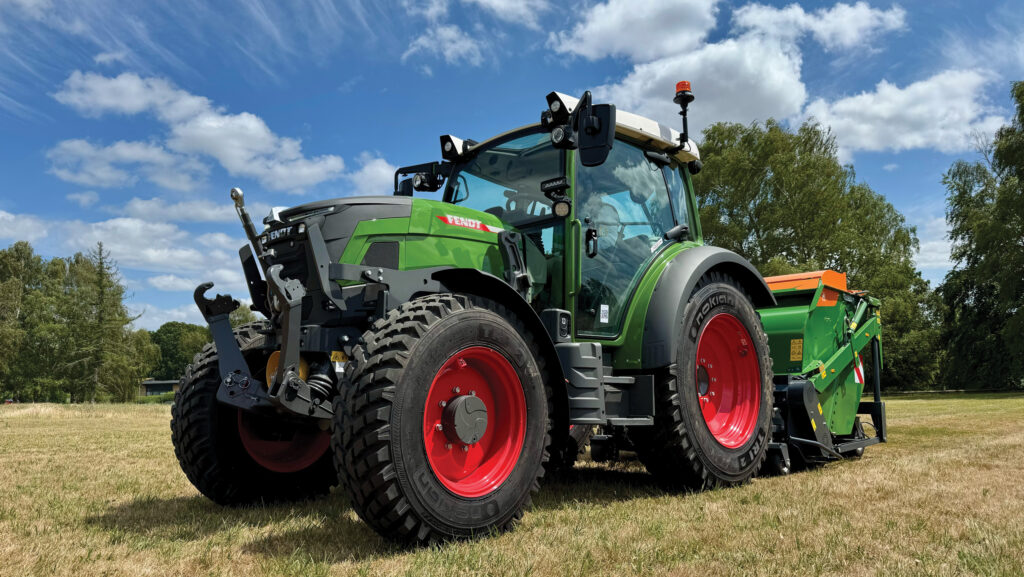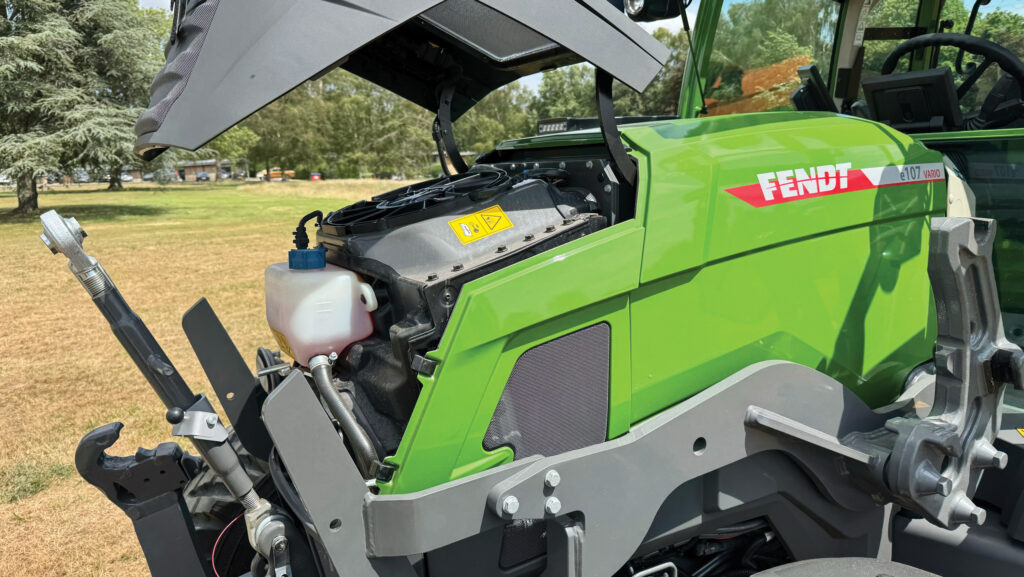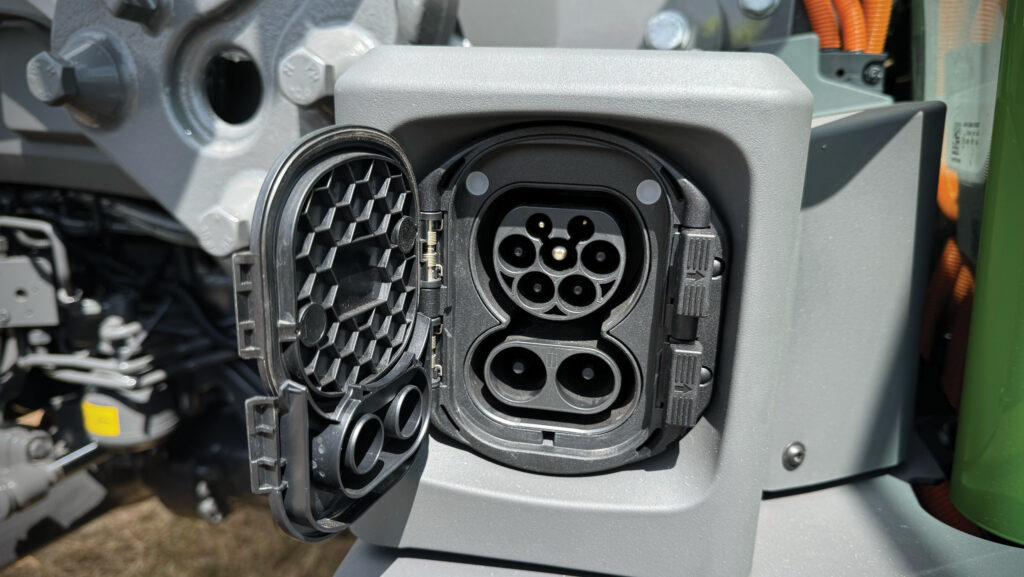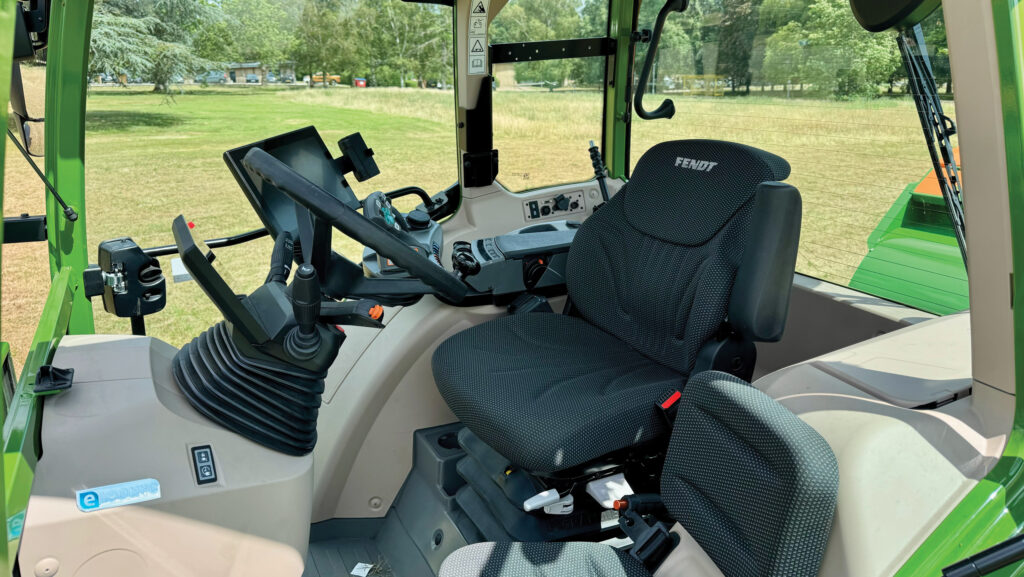Fendt puts £200k price on base spec 75hp e100 Vario electric tractor
 © MAG/Oliver Mark
© MAG/Oliver Mark Fendt has slapped a £200,000 base list price on its first full-size plug-in electric tractor, which is now on sale in the UK.
The 75hp e107S Vario is based on the firm’s established 200-series models, with a battery pack and motor replacing the three-cylinder engine.
Given the cost, most buyers are likely to emanate from the speciality crop and amenity sectors, giving the ag-reliant German manufacturer several new markets to go at.
See also: £50k Sabanto Steward kit gets Fendt 700s working autonomously
The attractions, for those with deep enough pockets, are much like other electric vehicles.
It’ll go about its business quietly – though not silently, as the motor whirrs surprisingly noisily under the cab – and, with zero tailpipe emissions, cleanly.
Fendt 75hp e100 Vario
- Max power 75hp
- Boosted power 90hp
- Max torque 347Nm
- Max AC/DC charging 22kW/80kW
- Battery 100kWh
- Top speed 40kph
- Hydraulics 113 litre/min, up to four valves
- Lift capacity 4.29t
- Starting price £199,000
However, with the gains come concessions. Foremost is run-time, estimated at an ambiguous four to seven hours when operating in its 68hp-limited eco mode with a “partial load”.
Think yard sweeping and lawn mowing. Fendt reckons a full charge equates to one-quarter of the 125-litre tank carried by its diesel equivalent.
Fine when factoring in the regular tea breaks of a council gang, maybe – less so when the lithium-ion cells start waving the white flag while rowing up hay with grey clouds gathering.
Charge time is between one and five hours depending on the plug available.
How does it work?
A drive motor and 100kWh battery pack – equivalent to that of the biggest Tesla cars – inhabit the space vacated by the engine.
A series of inverters get the incoming charge supply from AC to DC (the battery operates at 668V DC) then back to three-phase AC for the Danfoss permanent magnetic sync motor.
This spins at super-high rpm – the source of the driving whine – ahead of a gear set that winds it down to a suitable speed for the standard 40kph Vario transmission.
From there on, it’s identical to the diesel variant.
Operators can work in three modes: “eco” limited to 68hp, “dynamic” for 75hp, and a “dynamic+” setting for short, high-energy and battery-caning bursts of up to 90hp.
Other features include a DC/DC converter, which fulfils a role akin to that of an alternator by providing 13.8V for the lights and other ancillaries, and a new twin-fan cooling pack.

© MAG/Oliver Mark
This sucks air in from the sides, sending it upwards over the transmission oil cooler and forwards through the condenser.
What about charging?
Standard EV fare here, with automotive-style CCS2 plugs that mean it can be juiced while you bag groceries at the local supermarket.
Tapping into a rapid 80kW DC charger will feed the electrons straight into the battery, saving the need for the initial AC/DC inversion and getting it from 20% to 80% in 45mins.
However, this intense loading will punish the cells in the long-term.

© MAG/Oliver Mark
A 22kW AC charger offers gentler replenishment, with cycle times of between four and five hours; Fendt can provide a 11kW/22kW wallbox kit for £827 (excluding installation). Resorting to a trickle from a 13A socket is a 23-hour affair.
Neat features include the ability to set charge limits and an intended departure time – allowing the tractor to heat the battery to operational temperature ready for action – and an energy regeneration system.
This works via an exhaust brake-style button on the cab floor, allowing power to be harvested on downhill runs and when decelerating.
How ‘green’ is it?
Livery aside, the e100’s green credentials will be governed by how many hours it clocks, and therefore how quickly it can claw back the heavy carbon emissions associated with the production of its battery.
Fendt reckons the tipping point for bettering the lifetime emissions of a diesel model Vario is 2,500 hours.
That tally might come slower than usual, given the 200-series typically clock far fewer hours than a big field-work tractor – even without taking unavoidable charging downtime into account.
How much does it cost?
The full-size S version in Profi spec – the most basic available – retails at £199,000, and it’s £236,720 as pictured with a loader, linkage and pto on the front.
There’s also a narrow (1.28m-wide) vineyard-friendly V model, priced at £182,000. By comparison, list price of a 79hp 207S in Power spec is £115,000.
Then there’s the eight-year/8,000-hour warranty option. Sounds cheap(ish) at £2.46/hour, less so at £19,680 over the 8,000 hours.
However, running costs should be low – near negligible if there’s a free renewable electricity supply on-site – and, with fewer filters and less oil required, it should slash one-third off servicing and maintenance bills.
Same cab?
It’s much like any other Marktoberdorf-built machine inside, complete with FendtOne controls.
Spec options are limited to Profi and Profi+, with differences between the two mainly relating to the number of hydraulic outlets and how they are controlled.

© MAG/Oliver Mark
Up to four double-actors are available, fed by a 113-litre/min pump, and there’s the option of guidance, front linkage and pto.
As for carrying capacity, the S model weighs 400kg more than the diesel, at 4.5t, leaving 3t spare for cargo on the loader and linkages.
More powerful versions pending?
Unlikely, says Fendt.
Battery power is best suited to the sub-100hp sector, where machines are better able to exploit the efficiency and low energy costs of electricity without being completely inhibited by the added weight and lengthy charge time.
Comparatively, a 385hp 939 would need 16t worth of batteries to match the output of its 9-litre diesel engine.
That said, John Deere unveiled a prototype E-Power model capable of delivering up to 130hp, which suggests there is scope to go slightly bigger.
Hydrogen is expected to play a bigger role higher up the horsepower rankings, where the ability to quickly refuel is essential for field work.
Fendt showed its Helios prototype at Agritechnica in 2023, which paired a hydrogen fuel cell with a 25kWh battery to run a 100kW (134hp) electric motor.

